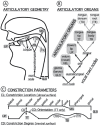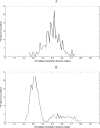Articulating What Infants Attune to in Native Speech
- PMID: 28367052
- PMCID: PMC5351798
- DOI: 10.1080/10407413.2016.1230372
Articulating What Infants Attune to in Native Speech
Abstract
To become language users, infants must embrace the integrality of speech perception and production. That they do so, and quite rapidly, is implied by the native-language attunement they achieve in each domain by 6-12 months. Yet research has most often addressed one or the other domain, rarely how they interrelate. Moreover, mainstream assumptions that perception relies on acoustic patterns whereas production involves motor patterns entail that the infant would have to translate incommensurable information to grasp the perception-production relationship. We posit the more parsimonious view that both domains depend on commensurate articulatory information. Our proposed framework combines principles of the Perceptual Assimilation Model (PAM) and Articulatory Phonology (AP). According to PAM, infants attune to articulatory information in native speech and detect similarities of nonnative phones to native articulatory patterns. The AP premise that gestures of the speech organs are the basic elements of phonology offers articulatory similarity metrics while satisfying the requirement that phonological information be discrete and contrastive: (a) distinct articulatory organs produce vocal tract constrictions and (b) phonological contrasts recruit different articulators and/or constrictions of a given articulator that differ in degree or location. Various lines of research suggest young children perceive articulatory information, which guides their productions: discrimination of between- versus within-organ contrasts, simulations of attunement to language-specific articulatory distributions, multimodal speech perception, oral/vocal imitation, and perceptual effects of articulator activation or suppression. We conclude that articulatory gesture information serves as the foundation for developmental integrality of speech perception and production.
Figures







Similar articles
-
Investigating the role of articulatory organs and perceptual assimilation of native and non-native fricative place contrasts.Dev Psychobiol. 2014 Feb;56(2):210-27. doi: 10.1002/dev.21195. Epub 2014 Jan 6. Dev Psychobiol. 2014. PMID: 24390820
-
Speech Sound Disorders in Children: An Articulatory Phonology Perspective.Front Psychol. 2020 Jan 28;10:2998. doi: 10.3389/fpsyg.2019.02998. eCollection 2019. Front Psychol. 2020. PMID: 32047453 Free PMC article. Review.
-
Examination of perceptual reorganization for nonnative speech contrasts: Zulu click discrimination by English-speaking adults and infants.J Exp Psychol Hum Percept Perform. 1988 Aug;14(3):345-60. doi: 10.1037//0096-1523.14.3.345. J Exp Psychol Hum Percept Perform. 1988. PMID: 2971765
-
Infant perception of non-native consonant contrasts that adults assimilate in different ways.Lang Speech. 2003;46(Pt 2-3):183-216. doi: 10.1177/00238309030460020701. Lang Speech. 2003. PMID: 14748444 Free PMC article.
-
Articulatory phonology: an overview.Phonetica. 1992;49(3-4):155-80. doi: 10.1159/000261913. Phonetica. 1992. PMID: 1488456 Review.
Cited by
-
Early development of abstract language knowledge: evidence from perception-production transfer of birth-language memory.R Soc Open Sci. 2017 Jan 18;4(1):160660. doi: 10.1098/rsos.160660. eCollection 2017 Jan. R Soc Open Sci. 2017. PMID: 28280567 Free PMC article.
-
Phonological Feature Abstraction Before 6 Months: Amodal Recognition of Place of Articulation Across Multiple Consonants.Dev Sci. 2025 Mar;28(2):e13605. doi: 10.1111/desc.13605. Dev Sci. 2025. PMID: 39810309 Free PMC article.
-
Speech Production From a Developmental Perspective.J Speech Lang Hear Res. 2019 Aug 29;62(8S):2946-2962. doi: 10.1044/2019_JSLHR-S-CSMC7-18-0130. Epub 2019 Aug 29. J Speech Lang Hear Res. 2019. PMID: 31465709 Free PMC article. Review.
-
Early Development of Neural Speech Encoding Depends on Age but Not Native Language Status: Evidence From Lexical Tone.Neurobiol Lang (Camb). 2022 Feb 10;3(1):67-86. doi: 10.1162/nol_a_00049. eCollection 2022. Neurobiol Lang (Camb). 2022. PMID: 37215329 Free PMC article.
-
Asymmetries in unimodal visual vowel perception: The roles of oral-facial kinematics, orientation, and configuration.J Exp Psychol Hum Percept Perform. 2018 Jul;44(7):1103-1118. doi: 10.1037/xhp0000518. Epub 2018 Mar 8. J Exp Psychol Hum Percept Perform. 2018. PMID: 29517257 Free PMC article.
References
-
- Anderson J. L., Morgan J. L., & White K. S. (2003). A statistical basis for speech sound discrimination. Language and Speech, , 155–182. - PubMed
-
- Aslin R. N., & Pisoni D. B. (1980). Some developmental processes in speech perception In Yeni-Komshian G. H., Kavanagh J. F., & Ferguson C. A. (Eds.), Child phonology (Vol. 2, pp. 67–96). New York, NY: Academic Press.
-
- Aslin R. N., Saffran J. R., & Newport E. L. (1998). Computation of conditional probability statistics by 8-month-old infants. Psychological Science, , 321–324.
-
- Auban J., & Ménard L. (2006). Compensation for a labial perturbation: An acoustic and articulatory study of child and adult French speakers. Proceedings of International Symposium on Speech Production (ISSP). Ubatuba, Brazil: CEFALA.
-
- Aziz-Zadeh L., Iacoboni M., Zaidel E., Wilson S., & Mazziotta J. (2004). Left hemisphere motor facilitation in response to manual action sounds. European Journal of Neuroscience, , 2609–2612. - PubMed
Grants and funding
LinkOut - more resources
Full Text Sources
Other Literature Sources
Miscellaneous
